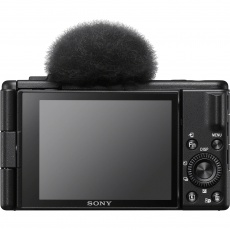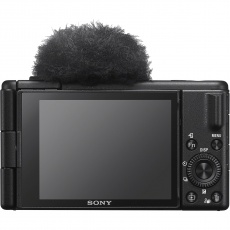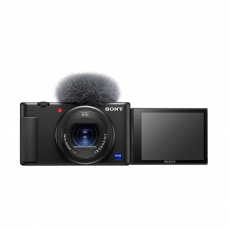Ultimate Buying Guide | Digital Compact Cameras
Buying a new camera can be a bit daunting. With the never ending march of progress, constant innovation in Mirrorless cameras, and supply issues across the globe, Compact cameras have become fewer and fewer over recent years.
This page will go over what is still available and what to look for when buying a compact camera, along with a few recommendations from our expert staff.
We will go into the technical details later but if all you’re looking for is a basic, super easy to use budget compact camera, here are a few options that offer the bare essentials;
OM System TG-7 - Easy to use, compact, shock & waterproof. Ideal travel companion without a compromise on quality
Sony ZV-1F- This compact camera is the ideal camera cor those intersted in video as well as stills. The perfect camera for the aspiring content creator.
Sony ZV-1M2 - The next level in content creation.
Tough TG-7
Sony ZV-1F
Sony ZV-1M2
Megapixels
Many people seem to gravitate towards the camera with the highest megapixels.This is not necessarily the most crucial factor when choosing the perfect camera. There are a few reasons why you may want to look at the megapixels, for example, large scale printing or the ability to crop into a photo and not lose quality. However, for most people this is not necessary. A little rule of thumb that we use - as long as it’s over 12 megapixels you’re probably not going to notice much of a difference. Most people are either going to be posting pictures online, or printing them to put into a photo album. For this, 12 megapixels is more than enough.
Zoom or low light?
Unfortunately, these rarely come as a pair. This is all down to the size of the camera’s sensor. The bigger the sensor, the better the camera will perform in low light. The smaller the sensor, the more the camera will be able to crop the image resulting in a big zoom.
For those of you who don’t know, the sensor is a part of the camera situated behind the lens, which records the image by reacting to the light that enters it. It works in a very similar way to film.
Having a bigger sensor in your camera can have a few benefits; this includes better image quality, the ability to get more of a blurred background (bokeh). But the main advantage is improved low light performance. This is because the bigger the surface area of the sensor will then have the ability to collect more light.
On the other hand, having a smaller sensor can sometimes be beneficial too, as it will give you the ability to have a huge zoom whist maintaining the small size of a compact camera. This is basically because the bigger the sensor of the camera, the bigger the lens will need to be to provide a big zoom.
It’s worth pointing out that if you are after both of these features, there are only a small handful of cameras that can provide a compromise between the two.
If you’re looking for a camera with a larger sensor which is better for low light, here are a few recommendations based on our top sellers. If you’re looking for cameras with a big zoom, skip this part!
Good Low Light Camera Recommendations
Sony RX100 Mark V. One of a long line of great cameras from Sony, the RX100 range of cameras that all feature a 1” sensor, great for capturing stunning quality photos with fantastic low light capabilities. While you are limited to a 3x optical zoom (24-70mm equivalent) with the Mark V. These tend to be very popular with professional photographers who are looking for a camera to fit in their pocket when they don’t want to lug around their big heavy camera bag!
Sony DSC-RX100 V
Canon GX7 Mark III. Another great camera with a 1” sensor which is also going to give you great quality low light photos. Features a 3x optical zoom (24-70mm equivalent). These cameras tend to be popular for people doing video, such as vlogging.
Sony ZV-1 This camera comes with a 1inch stacked CMOS sensor, which means that it is great for creating proffesional quality footage. The vari-angle LCD screen makes it flexible to take photographs at every angle. A directional 3-capsule mic and wind shield is supplied with this camera for recording high sound quality,
Canon Powershot G7 X Mark III
Sony ZV-1
Canon G1X III. This camera features a huge APS-C Sensor, which is usually what you’d expect to see in a lot of DSLRS and mirrorless cameras. So for this to be squeezed into a compact camera is quite impressive. This is going to offer exceptionally good low light performance! Just like the cameras suggested above, this offers a 3x optical zoom (24-70mm equivalent).
Canon Powershot G1 X Mark III
Big Zoom Lens Recommendations
If you’re looking for a COMPACT CAMERA WITH A BIG ZOOM, here are a couple of our top sellers;
Panasonic Lumix FZ2000. This is a great versatile camera which boasts a massive optical zoom Less compact than the others here, but a good all in one option. Also features an electronic viewfinder and manual controls.
Lumix FZ2000
Sony HX99. This is one of the smallest compacts that we sell that manages to pack in a whole load of features including a 30x optical zoom (24-720mm equivalent), pop up electronic view finder and manual controls.
Sony DSC-HX99
Both Low Light and Zoom Recommendations
If you’re looking for both LOW LIGHT AND ZOOM, there are a few exceptions that offer a compromise between the two. These include;
Panasonic TZ100 and TZ200. These both feature a 1” sensor making them great for low light, but also include a 10x optical zoom (25-250mm equivalent) for the TZ100, and a 15x optical zoom (24-360mm equivalent) for the TZ200. This makes a great compromise for those who want a good quality low light camera whilst also adding a bit of versatility with the zoom.
Sony RX100 VI and VII. If you can live with the slightly shorter focal range compared with the Lumiz TZ100 and TZ200, then the Sony RX100 VI and VII could also be potential contenders. They both feature a lens range equivalent to 24-200mm, however, they have a brighter aperture allowing more light to enter which means a cleaner, more detailed image when shooting in low light conditions.
Sony DSC-RX100 VII
Manual control
If you’re looking to get a bit more technical with your photography it may be worth looking at a camera that gives you more control over the way it takes the photo. This mainly includes giving you the ability to change the aperture, shutter speed and ISO, but there are also lots of other adjustments you can make, such as different focusing options and giving you the ability to save in RAW.
All of the Lumix TZ cameras shown in this article feature full manual control, along with the Sony RX100 range. The Canon G series also offers full manual control, however, the powershot sx620/740 and Ixus cameras do not.
Discover: Camera Bags - The Secret Tool Every Photographer Needs
View Finder
Viewfinders can help massively when it comes to composing a photograph. When you’re trying to take a photo outside, the bright light can cause a lot of glare on the screen which can make it very difficult to see what you’re doing! Using a viewfinder can help to eliminate that problem, as it will block most of the light. To see our full range of compacts featuring a viewfinder, click here.
Flip screen
Flip screens on a camera can have a few different benefits. Firstly, it can be very useful if you’re trying to take a picture at a bit of an awkward angle. For example, if you’re trying to take a picture from a low angle, you can quite simply tilt the screen up towards you to see what you’re doing as opposed to having to lie down on the floor! Another reason a lot of people go for cameras with flip screens is so they can flip the screen towards themselves to take a self-portrait!
It’s worth bearing in mind that a lot of cameras are slightly different in the way that they can tilt. Some are more limited than others.
See all the cameras we stock with a flip screen here.
The Canon Powershot G5 X Mark II is an example of a compact camera that features both a view finder and a flip screen. This camera combined with a premium wide-angle lens and a 5x zoom, means that there is a garantee for great performance and flexibility. A 20.1 megapixel 1.0-type CMOS sensor produces outstanding quality photos and 4K videos.
Sony HX99 Is an amazing small light, compact camera. This camera has an 18.2 megapixel CMOS sensor with a great 30x zeiss lens which is the equivalent to a 24-720mm focal range. This means that holiday and travel photographs can be taken with ease. The camera incorporates a easy-to-operate OLED tru finder which is far brighter than most conventional electronic viewfinders. It displays real-time previews, meaning that what is viewed in the viewfinder is exactly how the shot will turn out.
Video
When it comes to video, pretty much every compact camera out there can record video. But if you’re looking to get the best possible quality video from a compact camera, it may be worth looking at cameras that can record in 4K resolution. Not only will this future proof the camera, but it will also provide a much higher level of detail.
See all the cameras we list with 4K video here.
However it’s worth pointing out that there are still a lot of other factors that will help improve the video quality of a camera. Just because a camera states that it has the ability to record in 4K, it does not mean that it’s going to look as good as a £5,000 professional video camera that also happens to record in 4K.
4K is not for everyone, a 4K TV or display is still somewhat of a luxury for most people. This goes to show that on websites such as YouTube, there’s still a very large amount of professional videos that would be uploaded to only 1080p. If you don’t have anything to play your 4K videos back on, it may not be a feature you require. It may also require a pretty powerful computer when it comes to editing!
Did you find your answer?
Hopefully you now have a better idea about what is important to you when choosing your camera. You can browse the full list of all of our compact digital cameras here. If you would like to speak to someone about your choice please give us a ring or email us.
READ NEXT: Instant Photography - The Complete Guide















